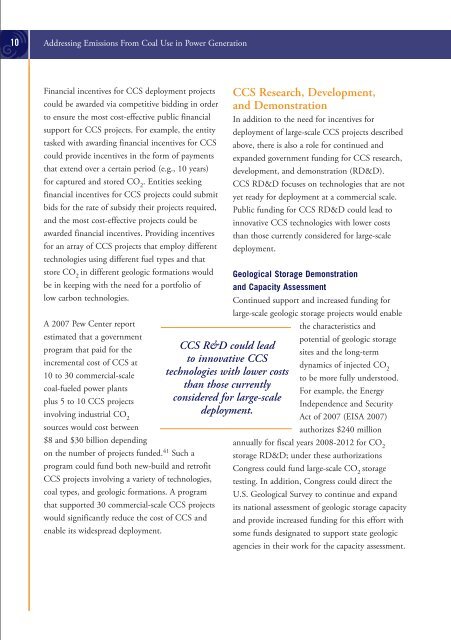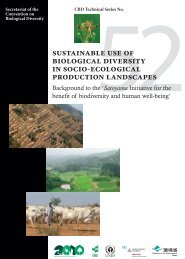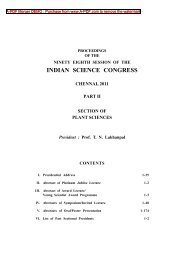Addressing Emissions From Coal Use in Power Generation ...
Addressing Emissions From Coal Use in Power Generation ...
Addressing Emissions From Coal Use in Power Generation ...
Create successful ePaper yourself
Turn your PDF publications into a flip-book with our unique Google optimized e-Paper software.
10 <strong>Address<strong>in</strong>g</strong> <strong>Emissions</strong> <strong>From</strong> <strong>Coal</strong> <strong>Use</strong> <strong>in</strong> <strong>Power</strong> <strong>Generation</strong><br />
F<strong>in</strong>ancial <strong>in</strong>centives for CCS deployment projects<br />
could be awarded via competitive bidd<strong>in</strong>g <strong>in</strong> order<br />
to ensure the most cost-effective public f<strong>in</strong>ancial<br />
support for CCS projects. For example, the entity<br />
tasked with award<strong>in</strong>g f<strong>in</strong>ancial <strong>in</strong>centives for CCS<br />
could provide <strong>in</strong>centives <strong>in</strong> the form of payments<br />
that extend over a certa<strong>in</strong> period (e.g., 10 years)<br />
for captured and stored CO 2<br />
. Entities seek<strong>in</strong>g<br />
f<strong>in</strong>ancial <strong>in</strong>centives for CCS projects could submit<br />
bids for the rate of subsidy their projects required,<br />
and the most cost-effective projects could be<br />
awarded f<strong>in</strong>ancial <strong>in</strong>centives. Provid<strong>in</strong>g <strong>in</strong>centives<br />
for an array of CCS projects that employ different<br />
technologies us<strong>in</strong>g different fuel types and that<br />
store CO 2<br />
<strong>in</strong> different geologic formations would<br />
be <strong>in</strong> keep<strong>in</strong>g with the need for a portfolio of<br />
low carbon technologies.<br />
A 2007 Pew Center report<br />
estimated that a government<br />
program that paid for the<br />
<strong>in</strong>cremental cost of CCS at<br />
10 to 30 commercial-scale<br />
coal-fueled power plants<br />
plus 5 to 10 CCS projects<br />
<strong>in</strong>volv<strong>in</strong>g <strong>in</strong>dustrial CO 2<br />
sources would cost between<br />
$8 and $30 billion depend<strong>in</strong>g<br />
on the number of projects funded. 41 Such a<br />
program could fund both new-build and retrofit<br />
CCS projects <strong>in</strong>volv<strong>in</strong>g a variety of technologies,<br />
coal types, and geologic formations. A program<br />
that supported 30 commercial-scale CCS projects<br />
would significantly reduce the cost of CCS and<br />
enable its widespread deployment.<br />
CCS R&D could lead<br />
to <strong>in</strong>novative CCS<br />
technologies with lower costs<br />
than those currently<br />
considered for large-scale<br />
deployment.<br />
CCS Research, Development,<br />
and Demonstration<br />
In addition to the need for <strong>in</strong>centives for<br />
deployment of large-scale CCS projects described<br />
above, there is also a role for cont<strong>in</strong>ued and<br />
expanded government fund<strong>in</strong>g for CCS research,<br />
development, and demonstration (RD&D).<br />
CCS RD&D focuses on technologies that are not<br />
yet ready for deployment at a commercial scale.<br />
Public fund<strong>in</strong>g for CCS RD&D could lead to<br />
<strong>in</strong>novative CCS technologies with lower costs<br />
than those currently considered for large-scale<br />
deployment.<br />
Geological Storage Demonstration<br />
and Capacity Assessment<br />
Cont<strong>in</strong>ued support and <strong>in</strong>creased fund<strong>in</strong>g for<br />
large-scale geologic storage projects would enable<br />
the characteristics and<br />
potential of geologic storage<br />
sites and the long-term<br />
dynamics of <strong>in</strong>jected CO 2<br />
to be more fully understood.<br />
For example, the Energy<br />
Independence and Security<br />
Act of 2007 (EISA 2007)<br />
authorizes $240 million<br />
annually for fiscal years 2008-2012 for CO 2<br />
storage RD&D; under these authorizations<br />
Congress could fund large-scale CO 2<br />
storage<br />
test<strong>in</strong>g. In addition, Congress could direct the<br />
U.S. Geological Survey to cont<strong>in</strong>ue and expand<br />
its national assessment of geologic storage capacity<br />
and provide <strong>in</strong>creased fund<strong>in</strong>g for this effort with<br />
some funds designated to support state geologic<br />
agencies <strong>in</strong> their work for the capacity assessment.

















